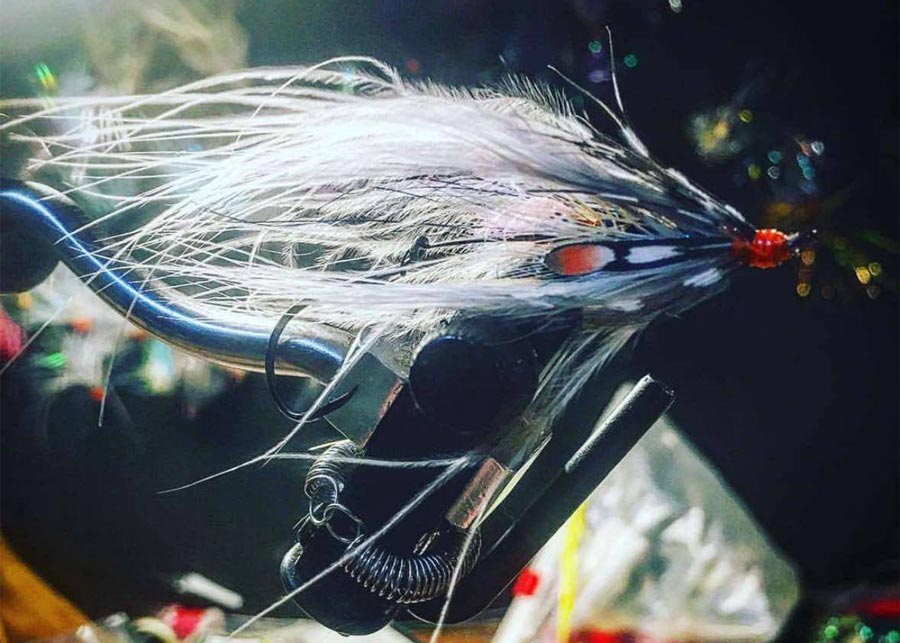

Written by: Kubie Brown
I’m a bit of an Intruder fly addict. I love fishing them for steelhead, salmon, and trout. There’s just something about the enticing way intruders wiggle in the water and the way that they feel on the swing that gives me confidence every time I tie one on. However, what I think I love most about intruder flies is tying them.
Unlike other swing-style flies, where you’re often simply wrapping long chunks of material on a hook, when you tie an Intruder, every feather, every hackle, and every bit of flash has its own purpose. It’s a fly you design to tempt and to attract, and as soon as you pull the pattern from your vise, you can practically imagine the fish turning and chasing it down. Intruders are all about creativity, and while there are dozens of different materials you can use, it always starts with the shank. And I’ve never found a better base for feeding my intruder fly addiction than Senyo’s Articulated Steelhead and Salmon Shanks.

Trout-size shanks are great for covering water on larger rivers. Photo: Kubie Brown
Right Size for The Fish
One of the biggest issues I’ve had with other fly tying shanks that I’ve used is that they never seem to be the right size. Most are either too small, forcing you to stack up and extend materials to add bulk, or they’re so large that you have to skimp on the good stuff and your fly ends up swinging like a waterlogged stick. However, Senyo Shanks come in three different sizes—20mm, 25mm, and 40mm—with each size ideal for a different species.
I use 20mm shanks for tying small, intricate intruders that are perfect for trout in small streams and rivers. However, when I need to add a bit more material or I’m targeting larger fish, I’ll use a 25mm. These mid-size shanks are also ideal for tying lighter flies with longer materials when I’m after summer steelhead or when fishing Scandi-style lines. Finally, when I’m after big winter steelhead or aggressive Pacific salmon, I turn to the 40mm shanks, which are ideal for tying the bulky, heavily weighted intruder patterns I need to get those stubborn fish to pay attention.

Tying salmon and steelhead patterns on these shanks is remarkably simple. Photo: Kubie Brown
Simple and Strong
The other thing that makes Senyo Shanks stand out is that they’re simple and easy to use. Designed with a classic upturned eye on the front and a rear vertical loop on the back, Senyo Shanks save you all that awkward fumbling with your vise when you’re trying to make a shank stick. Instead of trying to finagle a thin metal stick into your vice and having it stay still while you awkwardly pull and twist material onto it, the rear vertical loop on the Senyo Shank clamps in as solidly as any hook shank. This allows you to tie with confidence without having to worry about accidentally pulling the fly loose at a critical moment.
The final thing I like about Senyo Shanks is that they’re strong. Made of an anodized stainless-steel wire, Senyo Shanks are stable in your vise, no matter how hard you pull on or twist them. Once you tie a fly with them, the bug will never bend or break, no matter how large or angry the fish is that you hook. In short, when you tie an intruder with a Senyo Shank, you’re tying a fly that’s going to last.
The Artist’s Way
Intruders are among those things that anglers either love or hate. Many anglers find them too complicated to tie and don’t want to spend so much time creating a fly they’re likely going to snag on a rock and lose to the bottom of the river. However, for the rest of us, that’s part of the pattern’s appeal. To invest your time and create something beautiful that may have a short life is a lovely sentiment about existence . . . plus, Intruders just catch a lot of fish.
Trending Products











